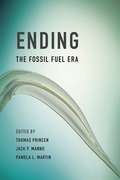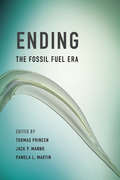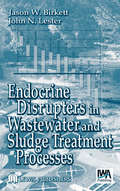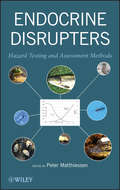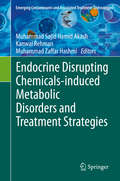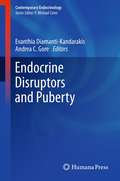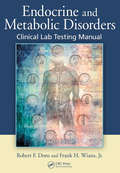- Table View
- List View
Ending The U.s. War In Iraq
by Ben Connable Terrence K. Kelly Charles P. Ries Richard R. Brennan Larry HanauerEnding the U. S. war in Iraq required redeploying 100,000 military and civilian personnel; handing off responsibility for 431 activities to the Iraqi government, U. S. embassy, USCENTCOM, or other U. S. government entities; and moving or transferring ownership of over a million pieces of property in accordance with U. S. and Iraqi laws, national policy, and DoD requirements. This book examines the planning and execution of this transition.
Ending the Fossil Fuel Era
by Thomas Princen Pamela L. Martin Jack P. MannoNot so long ago, people North and South had little reason to believe that wealth from oil, gas, and coal brought anything but great prosperity. But the presumption of net benefits from fossil fuels is eroding as widening circles of people rich and poor experience the downside.A positive transition to a post-fossil fuel era cannot wait for global agreement, a swap-in of renewables, a miracle technology, a carbon market, or lifestyle change. This book shows that it is now possible to take the first step toward the post-fossil fuel era, by resisting the slow violence of extreme extraction and combustion, exiting the industry, and imagining a good life after fossil fuels. It shows how an environmental politics of transition might occur, arguing for going to the source rather than managing byproducts, for delegitimizing fossil fuels rather than accommodating them, for engaging a politics of deliberately choosing a post-fossil fuel world. Six case studies reveal how individuals, groups, communities, and an entire country have taken first steps out of the fossil fuel era, with experiments that range from leaving oil under the Amazon to ending mountaintop removal in Appalachia.
Ending the Fossil Fuel Era
by Thomas Princen Pamela L. Martin Jack P. MannoNot so long ago, people North and South had little reason to believe that wealth from oil, gas, and coal brought anything but great prosperity. But the presumption of net benefits from fossil fuels is eroding as widening circles of people rich and poor experience the downside.A positive transition to a post-fossil fuel era cannot wait for global agreement, a swap-in of renewables, a miracle technology, a carbon market, or lifestyle change. This book shows that it is now possible to take the first step toward the post-fossil fuel era, by resisting the slow violence of extreme extraction and combustion, exiting the industry, and imagining a good life after fossil fuels. It shows how an environmental politics of transition might occur, arguing for going to the source rather than managing byproducts, for delegitimizing fossil fuels rather than accommodating them, for engaging a politics of deliberately choosing a post-fossil fuel world. Six case studies reveal how individuals, groups, communities, and an entire country have taken first steps out of the fossil fuel era, with experiments that range from leaving oil under the Amazon to ending mountaintop removal in Appalachia.
Ending the Fossil Fuel Era (The\mit Press Ser.)
by Thomas Princen Pamela L. Martin Jack P. MannoA provocative call for delegitimizing fossil fuels rather than accommodating them, accompanied by case studies from Ecuador to Appalachia and from Germany to Norway.Not so long ago, people North and South had little reason to believe that wealth from oil, gas, and coal brought anything but great prosperity. But the presumption of net benefits from fossil fuels is eroding as widening circles of people rich and poor experience the downside.A positive transition to a post-fossil fuel era cannot wait for global agreement, a swap-in of renewables, a miracle technology, a carbon market, or lifestyle change. This book shows that it is now possible to take the first step toward the post-fossil fuel era, by resisting the slow violence of extreme extraction and combustion, exiting the industry, and imagining a good life after fossil fuels. It shows how an environmental politics of transition might occur, arguing for going to the source rather than managing byproducts, for delegitimizing fossil fuels rather than accommodating them, for engaging a politics of deliberately choosing a post-fossil fuel world. Six case studies reveal how individuals, groups, communities, and an entire country have taken first steps out of the fossil fuel era, with experiments that range from leaving oil under the Amazon to ending mountaintop removal in Appalachia.
Endless Forms Most Beautiful: The New Science of Evo Devo
by Sean B. Carroll"A beautiful and very important book."--Lewis Wolpert, American Scientist For over a century, opening the black box of embryonic development was the holy grail of biology. Evo Devo--Evolutionary Developmental Biology--is the new science that has finally cracked open the box. Within the pages of his rich and riveting book, Sean B. Carroll explains how we are discovering that complex life is ironically much simpler than anyone ever expected.
Endless Forms Most Beautiful: The New Science of Evo Devo and the Making of the Animal Kingdom
by Sean B. CarrollWe not only share nearly 99% of our genes with chimps, we also have some 35% in common with daffodils. Throughout much of the animal and even plant kingdoms, almost the same ancient genes code for almost the same proteins. And further, to everyone's astonishment, the genes involved in making the complex eyes of fruitflies are close matches to those involved in making the very different eyes of octopuses and people. So what leads to the nature's 'endless forms most beautiful'? The key to this mystery is being unravelled by 'Evo Devo' or the new science of evolutionary development biology. By looking at how a single-celled egg gives rise to a complex, multi-billion celled animal, Evo Devo is illuminating exactly how new species - butterflies and zebras, trilobites and dinosaurs, apes and humans - are made and evolved. The key, it turns out, is all about location and timing... For anyone who has ever pondered 'where did I come from', Endless Forms Most Beautiful explores our history, both the journey we have all made from egg to adult, and the long trek from the origin of life to the very recent origin of our species.
Endless Forms: The Secret World of Wasps
by Seirian Sumner“A book that draws us in to the strange beauty of what we so often run away from.” — Robin Ince, author of The Importance of Being InterestedIn this eye-opening and entertaining work of popular science in the spirit of The Mosquito, Entangled Life, and The Book of Eels, a leading behavioural ecologist transforms our understanding of wasps, exploring these much-maligned insects’ secret world, their incredible diversity and complex social lives, and revealing how they hold our fragile ecosystem in balance.Everyone worries about the collapse of bee populations. But what about wasps? Deemed the gangsters of the insect world, wasps are winged assassins with formidable stings. Conduits of Biblical punishment, provokers of fear and loathing, inspiration for horror movies: wasps are perhaps the most maligned insect on our planet. But do wasps deserve this reputation?Endless Forms opens our eyes to the highly complex and diverse world of wasps. Wasps are 100 million years older than bees; there are ten times more wasp species than there are bees. There are wasps that spend their entire lives sealed inside a fig; wasps that turn cockroaches into living zombies; wasps that live inside other wasps. There are wasps that build citadels that put our own societies to shame, marked by division of labor, rebellions and policing, monarchies, leadership contests, undertakers, police, negotiators, and social parasites. Wasps are nature’s most misunderstood insect: as predators and pollinators, they keep the planet’s ecological balance in check. Wasps are nature’s pest controllers; a world without wasps would be just as ecologically devastating as losing the bees, or beetles, or butterflies.Wasps are diverse and beautiful by every measure, and they are invaluable to planetary health, Professor Sumner reminds us; we’d do well to appreciate them as much as their cuter cousins, the bees.
Endless Frontier: Vannevar Bush, Engineer of the American Century
by G. Pascal ZacharyA prodigiously researched biography of Vannevar Bush, one of America’s most awe-inspiring polymaths and the secret force behind the biggest technological breakthroughs of the twentieth century.As the inventor and public entrepreneur who launched the Manhattan Project, helped to create the military-industrial complex, conceived a permanent system of government support for science and engineering, and anticipated both the personal computer and the Internet, Vannevar Bush is the twentieth century’s Ben Franklin. In this engaging look at one of America’s most awe-inspiring polymaths, writer G. Pascal Zachary brings to life an American original—a man of his time, ours, and beyond. Zachary details how Bush cofounded Raytheon and helped build one of the most powerful early computers in the world at MIT. During World War II, he served as Roosevelt’s adviser and chief contact on all matters of military technology, including the atomic bomb. He launched the Manhattan Project and oversaw a collection of 6,000 civilian scientists who designed scores of new weapons. After the war, his attention turned to the future. He wrote essays that anticipated the rise of the Internet and boldly equated national security with research strength, outlining a system of permanent federal funding for university research that endures to this day. However, Bush’s hopeful vision of science and technology was leavened by an understanding of the darker possibilities. While cheering after witnessing the Trinity atomic test, he warned against the perils of a nuclear arms race. He led a secret appeal to convince President Truman not to test the Hydrogen Bomb and campaigned against the Red Scare. Elegantly and expertly relayed by Zachary, Vannevar’s story is a grand tour of the digital leviathan we know as the modern American life.
Endless Immunity: Rethinking the Immune System
by Marc DaëronThis book takes the reader on an inspiring journey into the immune system, challenging long-held beliefs about immunity. It examines the immune system under historical, philosophical and biological perspectives. It proposes a new way of understanding immunity that goes beyond the binary opposition between self and non-self. Indeed, we, the livings, are chimeras. Mammals, birds, reptiles or fish, insects, spiders or mollusks, plants or algae, we are all made up of a community of living beings who share their lives in the same 'meta-organism'. If we live together, it is because we need each other to live, and if we can live together, it is because an immune system makes it possible, by adapting us to them and by adapting them to us. From this mutual adaptation a new kind of immunity emerges, dynamic, relational, never acquired, an endless immunity. Immunity that this system makes possible is not perfect, far from it, it is a compromise which does not always prevent disease; sometimes it even causes it. Disease is the cost of immunity. Because what the immune system enables is much more essential than the defense of the organism, it is the very existence of the meta-organism that we are. Immunity is more than a protection; it is a condition of existence. With its didactic structure and accessible style, this book is an essential resource for anyone interested in understanding the nature and function of the immune system. It also offers different levels of complexity from which the reader can choose, depending on his or her background, without compromising the main message of the text. With a Foreword from Alfred I. Tauber
Endless Novelties of Extraordinary Interest: The Voyage of H.M.S. Challenger and the Birth of Modern Oceanography
by Doug MacdougallA gripping tale of exploration aboard H.M.S. Challenger, an expedition that laid the foundations for modern oceanography From late 1872 to 1876, H.M.S. Challenger explored the world’s oceans. Conducting deep sea soundings, dredging the ocean floor, recording temperatures, observing weather, and collecting biological samples, the expedition laid the foundations for modern oceanography. Following the ship’s naturalists and their discoveries, earth scientist Doug Macdougall engagingly tells a story of Victorian-era adventure and ties these early explorations to the growth of modern scientific fields. In this lively story of discovery, hardship, and humor, Macdougall examines the work of the expedition’s scientists, especially the naturalist Henry Moseley, who rigorously categorized the flora and fauna of the islands the ship visited, and the legacy of John Murray, considered the father of modern oceanography. Macdougall explores not just the expedition itself but also the iconic place that H.M.S. Challenger has achieved in the annals of ocean exploration and science.
Endless Universe: Beyond the Big Bang
by Paul J. Steinhardt Neil TurokThe first serious challenge to the widely accepted 'Big Bang' model of the universe. According to 'Big Bang' theory, space and time sprang into existence fifteen billion years ago: a super-heated fireball of near infinite density that expanded at phenomenal speed. As it continued to expand, it cooled and condensed to create the galaxies, stars and planets we see today. But the theory has always had flaws and they have become increasingly difficult to reconcile. Why is the distribution of matter and ra...
Endlessly Green
by Savita HiremathEndlessly Green looks at the history, the science and the art of composting and sustainable waste management through a kaleidoscope of philosophical, moral and ethical intricacies. The author digs into her rich pool of experiential learnings and raw inputs gathered through a decade of research, legwork and fearless execution. This engaging field guide equips community volunteers, activists, students, SWM practitioners and professionals with practical inputs on segregation, composting and organic gardening/farming, making sustainability imaginable in a concrete jungle. In doing so, it helps individuals discover the possibilities of bringing about a change in their environment by engaging their own environmental sensibilities. Endlessly Green is an extraordinary celebration of things small and significant and the fight against waste, culminating in a replicable and scalable end-to-end solution.
Endlich Biochemie verstehen
by Jonathan Wolf MuellerDieses Buch beantwortet brennende Fragen nach dem (molekularen) Sinn des Lebens und macht Lust auf mehr. Was ist es denn „was die Welt, im Innersten zusammenhält“. Das Buch ist als Lehrbuch konzipiert und macht übergeordnete Konzepte der Biochemie mit einfachen Bildern begreifbar. Die Konzepte oder spannenden Fragen der Kapitel werden mit viel Witz und über einfache Eselsbrücken den Studierenden näher gebracht.
Endocannabinoid Signaling
by Mauro MaccarroneThisvolume encompasses all major methodologies to interrogate endocannabinoidsystems (ECS) and endocannabinoids (eCBs) signaling. With increasing interesttowards the manifold activities of eCBs, this book discusses the chemical,biochemical, and molecular biological assays, and activity of distinct elementsof the ECS. These include membrane, nuclear receptors, biosynthetic andhydrolytic enzymes, and membrane transporters and oxidative enzymes. Written inthe highly successful Methods in Molecular Biology series format,chapters include introductions to their respective topics, lists of thenecessary materials and reagents, step-by-step, readily reproducible laboratoryprotocols, and tips on troubleshooting and avoiding known pitfalls. Timely and cutting edge, Endocannabinoid Signaling: Methods and Protocolsis a valuable resource and will help chemists, drug designers, biochemists,molecular biologists, cell biologists, pharmacologists, and (electro)physiologists navigate the mare magnum of endocannabinoid research.
Endocannabinoid Signaling: Methods and Protocols (Methods in Molecular Biology #2576)
by Mauro MaccarroneThis second edition provides new and updated chapters detailing all major elements of the ECB system. Chapters guide readers through identification of drug targets, electrophysiology, computational chemistry, and machine learning. Written in the successful Methods in Molecular Biology series format, chapters include introductions to their respective topics, lists of the necessary materials and reagents, step-by-step, readily reproducible protocols, and notes on troubleshooting and avoiding known pitfalls. Comprehensive and cutting-edge, Endocannabinoid Signaling: Methods and Protocols, Second Edition is a valuable resource for all researchers interested in learning more about this important and developing field.
Endocrine Disrupters in Wastewater and Sludge Treatment Processes
by Jason W. Birkett John N. LesterEndocrine Disrupting Chemicals (EDCs) have been shown to produce changes in the endocrine system of organisms, leading to increases in cancers and abnormalities in reproductive structure and function. This book presents research on the endocrine-disrupting effects of sewage and industrial effluents, covering the sources, fate, and transport of EDCs
Endocrine Disrupters: Hazard Testing and Assessment Methods
by Peter MatthiessenEnables researchers to assess the effects of endocrine disrupters as well as comply with new environmental regulations Endocrine disrupters are chemicals—both man-made and natural—that interfere with the body's endocrine system, potentially resulting in adverse developmental, reproductive, neurological, and immune effects. In recent years, a number of regulatory authorities around the world have drafted or enacted legislation that requires the detection and assessment of the effects of endocrine disrupters on both humans and wildlife. In response, this book provides comprehensive, up-to-date information on the latest tested and proven methods used to detect and assess the environmental hazards posed by endocrine-disrupting chemicals. Endocrine Disrupters is divided into chapters covering each major taxon as well as chapters dedicated to hazard assessment and regulation. The book covers testing methods for all the vertebrate groups and several invertebrate phyla, including: Crustaceans and mollusks Insects Fish Amphibians and reptiles Birds and mammals Moreover, the book emphasizes practical, ethical testing methods that combine sensitivity, efficiency, statistical power, and reasonable cost. Each chapter is written by one or more international experts in ecotoxicology, offering readers step-by-step guidance for implementing each method based on the latest research and the authors' firsthand laboratory experience. Furthermore, all the chapters have been subjected to a rigorous peer review and edited in light of the reviewers' comments. References at the end of each chapter guide readers to the literature in the field. Endocrine Disrupters is recommended for scientists who need to test chemicals for possible endocrine-disrupting properties. It is also recommended for regulatory authorities who need to decide whether particular chemicals can be safely marketed.
Endocrine Disrupting Chemicals-induced Metabolic Disorders and Treatment Strategies (Emerging Contaminants and Associated Treatment Technologies)
by Muhammad Zaffar Hashmi Muhammad Sajid Hamid Akash Kanwal RehmanThis volume offers a detailed and comprehensive analysis of Endocrine Disrupting Chemicals (EDCs), covering their occurrence, exposure to humans and the mechanisms that lead to the parthogenesis of EDCs-induced metabolic disorders. The book is divided into three parts. Part I describes the physiology of the human endocrine system, with special emphasis on various types of metabolic disorders along with risk factors that are responsible for the development of these disorders. Part II addresses all aspects of EDCs, including their role in the induction of various risk factors that are responsible for the development of metabolic disorders. Part III covers up-to-date environmental regulatory considerations and treatment strategies that have been adopted to cure and prevent EDCs-induced metabolic disorders. This section will primarily appeal to clinicians investigating the causes and treatment of metabolic disorders. The text will also be of interest to students and researchers in the fields of Environmental Pharmacology and Toxicology, Environmental Pollution, Pharmaceutical Biochemistry, Biotechnology, and Drug Metabolism/Pharmacokinetics.
Endocrine Disruption Modeling (QSAR in Environmental and Health Sciences)
by James DevillersUses Computational Tools to Simulate Endocrine Disruption PhenomenaEndocrine Disruption Modeling provides a practical overview of the current approaches for modeling endocrine activity and the related potential adverse effects they may induce on environmental and human health. Based on the extensive research of an international panel of contributor
Endocrine Disruptors and Puberty
by Evanthia Diamanti-Kandarakis Andrea C. GoreEndocrine disruption represents one of the most controversial environmental issues of our time. Mounting evidence stemming from more than 10 years of experimental, epidemiological and clinical studies has transformed the once generally discounted subject of endocrine disruptors into an issue of tremendous concern not only within the scientific community but among society as a whole. Following initial evidence from basic research, endocrine disruption in humans has now emerged as a major medical challenge. In this respect, puberty, a crucial developmental stage, has been definitively identified as a key window of vulnerability with regard to endocrine disruptors. Written by leading authorities in the field, Endocrine Disruptors and Puberty offers an engaging and comprehensive overview of this fascinating and rapidly growing problem. An indispensable resource for all clinicians and scientists interested in this challenging endocrinologic topic, Endocrine Disruptors and Puberty is a timely contribution that will help navigate a path toward understanding the problem and developing solutions.
Endocrine Pathology (Encyclopedia of Pathology)
by Stefano La Rosa Silvia UccellaThis encyclopedia volume covers the complete field of endocrine pathology – from Acidophil Stem Cell Adenoma to Waterhouse-Friderichsen syndrome. The alphabetically arranged entries, each of which provides a detailed description of a specific pathological disease pattern, allow readers to quickly and easily find the information they need.
Endocrine Toxicology (Target Organ Toxicology Series)
by John A. Thomas Howard D. ColbyThis text presents a range of topics from the molecular events surrounding hormone actions to epidemiologic studies of the effects of environmental and occupational chemicals on reproductive organs. The endocrine systems covered include the adrenal cortex, thyroid and parathyroid, gonads, and the endocrine pancreas. Of particular importance are the
Endocrine Toxicology (Target Organ Toxicology Series)
by J. Charles Eldridge James T. StevensWith contributions by international experts in academia, chemical manufacturing, government research laboratories, regulatory agencies, and private consulting, this guide explores the potentially damaging influence of environmental agents on the endocrine system. It examines endocrine toxicology's increased importance in environmental safety issues
Endocrine and Metabolic Disorders: Clinical Lab Testing Manual, Fourth Edition
by Robert F. Dons Frank H. Wians Jr.Bottom Line Information to Effectively Diagnose DisordersThe diagnosis, management, and clinical testing associated with old, traditional, and new endocrine disorders have seen numerous advances during the past 10 years since the publication of the previous edition of this bestselling resource. Updating its classic predecessor in content and format
Endocrinology of Social Relationships
by Peter B. Gray Peter T. EllisonIn social relationships―whether between mates, parents and offspring, or friends―we find much of life’s meaning. But in these relationships, so critical to our well-being, might we also detect the workings, even directives, of biology? This book, a rare melding of human and animal research and theoretical and empirical science, ventures into the most interesting realms of behavioral biology to examine the intimate role of endocrinology in social relationships. <P><P>The importance of hormones to reproductive behavior―from breeding cycles to male sexual display―is well known. What this book considers is the increasing evidence that hormones are just as important to social behavior. Peter Ellison and Peter Gray include the latest findings―both practical and theoretical―on the hormonal component of both casual interactions and fundamental bonds. The contributors, senior scholars and rising scientists whose work is shaping the field, go beyond the proximate mechanics of neuroendocrine physiology to integrate behavioral endocrinology with areas such as reproductive ecology and life history theory. Ranging broadly across taxa, from birds and rodents to primates, the volume pays particular attention to human endocrinology and social relationships, a focus largely missing from most works of behavioral endocrinology.

